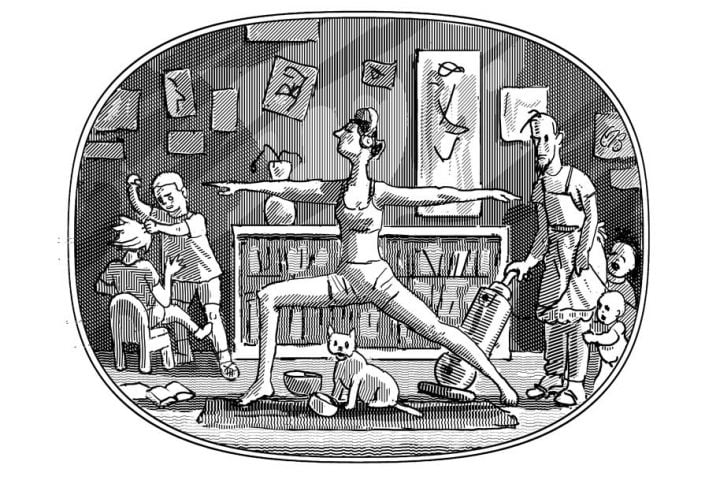Books Reviewed
My reading year in 2020 began with Christopher Caldwell’s brilliant book The Age of Entitlement: America Since the Sixties, and ended with Helen Andrews’s equally impressive Boomers: The Men and Women Who Promised Freedom and Delivered Disaster. There was a lovely symmetry about this chance pairing, since the two histories have in common a magisterial contempt for the self-celebratory media narrative—which has now also become the official culture’s historical narrative—about the period they cover. That is, of course, the now legendary 1960s and the political and cultural legacy that those, like me, who came of age in that decade have carried forward into the present and are now on the point of bequeathing to their Gen-X and Millennial successors. To those, like me, who have long chafed under the constraints of that now-antiquated narrative, both books convey a sense of liberation as well as new understanding.
The editor of the American Conservative, Andrews modeled her book, she tells us, after Lytton Strachey’s Eminent Victorians, but I think this is a bit misleading. She reads Strachey—as, to be fair, many others have done—as a kind of proto-Boomer, inspired by the First World War as the actual Boomers were by Vietnam to denounce the hypocrisy and corruption of the generation before him, seen as responsible for the war. This comparison is not entirely false, and the disgust of the youth of the 1920s with their parents and their parents’ values must have had a lot to do with the popularity of Eminent Victorians during that decade. But it is quite a stretch to apportion any share of blame for World War I to Strachey’s four subjects, all of whom were not one generation behind Strachey (b. 1880) but at least two or three and dead before he wrote of them. Thomas Arnold of Rugby (b. 1795) was at least four generations his senior and died more than 70 years before the Guns of August made their report.
Strachey’s beef with the old-timers, insofar as it was anything more than aesthetic or stylistic, was not generational but epochal—a subject to which we shall return. Ms. Andrews’s focus on a more narrowly generational shift takes not four but six representative figures of the baby-boom generation for her attention: Steve Jobs, Aaron Sorkin, Jeffrey Sachs, Camille Paglia, Al Sharpton, and Sonia Sotomayor. She never quite gets around to telling us exactly what the six have in common, apart from the generational window in which they were born, but if I may presume to supply my own answer to the question it would be that all of them share a devout belief in what the English call doing well by doing good. All, that is, seem to have made the same delightful discovery as a great many others of their generation: that what is good for them is also good for the whole world.
***
That is a perfect formula for keeping youthful idealism alive into old age—and thus never learning anything from experience, as so many of the Boomers appear not to have done. Andrews’s book is full of amusing examples—at least they are amusing to anyone who doesn’t share the Boomers’ invincible self-satisfaction—as when she quotes historian Anne Gardiner Perkins’s apparently straight-faced explanation of the reason for the introduction of co-education at her alma mater: “If Yale was going to keep its standing as one of the top two or three colleges in the nation, the availability of women was an amenity it could no longer do without.” Another favorite of mine is Google executive Eric Schmidt’s explanation to the World Economic Forum at Davos of why his company decided to go into the Chinese market in spite of the Communist government’s censorship: “We actually did an evil scale,…[and] we concluded that although we weren’t wild about the restrictions, it was even worse not to try to serve those users at all.” This is quoted by way of contrast with Steve Jobs, who always resisted the pressure to outsource to China as his successor, Tim Cook, did not, and it is one way in which the former was not just typical of, but better than, his generation.
Camille Paglia, enemy of cant that she is, is another who doesn’t quite fit the generational template, which may be part of the reason why, although Andrews finds things to admire as well as to criticize about all six of her subjects, the balance between admiration and criticism seems a bit more tilted toward the former in Ms. Paglia’s case than in that of any of the others. She begins her chapter on the author of Sexual Personae by calling attention to the comparisons that were made in 1990, when that book burst like an ICBM on the cultural scene of post-Cold War America, between this new celebrity intellectual (an increasingly rare breed, as Andrews points out) and Susan Sontag, the intellectuals’ pin-up of the previous generation.
This made me wonder if, at the back of her mind, Helen Andrews had ever entertained the idea that she was Camille Paglia’s natural successor, in her generation, as Paglia had been Susan Sontag’s 30 years earlier. I know I’d vote for her. Her wit and lively, sparkling prose are not unlike those of the now grande dame of 74 (whose writing still sounds the same as it did 30 years ago), and her critical judgments, while often of equal asperity, are generally more measured and generous. There are too many examples for me to pick just one, but I can’t resist reproducing this little gem:
In the 1990s comedy sequel [to the 1960s], every last one of America’s parents could have been convinced that colleges were all subliterate orgy dens, and political correctness would still have rolled on undaunted, because there was no chance those parents were going to let their children neglect to get a college degree. The credential was too important, and getting more important all the time. No matter how ridiculous particular institutions were made to look, college in general became only a bigger and bigger slice of the national economy. In the first hundred days of his presidency Barack Obama proposed spending $12 billion on community colleges, which, if it had passed Congress, would only have resulted in more states deciding that firemen and state troopers must learn how to put their footnotes in MLA format before we give them permission to save our lives. The effect that credential inflation has had on the professoriat is easy to imagine. When they see that they have the power to make a man who once would have been an adult with a wife and kid instead sit in a cage well into his mid-twenties, taking creative writing from some goateed drudge, they don’t worry whether they have the power to get away with a comparative bagatelle like gender neutral pronouns.
***
This passage occurs in the chapter on Paglia but really has nothing to do with her, apart from explaining, in part, the mutual contempt felt by her and the academic establishment which has so largely excluded her for heterodoxy. But such digressions must have been thought necessary to enliven the book’s otherwise Strachey-like descriptions of people who, because of their incapacity for growth or change, are really not very interesting as people. The chapter on Sonia Sotomayor, in particular, is much more about the revolution in jurisprudence of the last 60 years, especially the growth of public interest law, than it is about Justice Sotomayor herself.
Andrews mainly criticizes Paglia for squandering her genius on pop-cultural ephemera and for her wrong-headed celebration of pornography—more, I always think, to tweak the Puritanical feminists who were her frequent target than because she actually likes the stuff. Though Paglia is not so self-righteous as Aaron Sorkin or Jeffrey Sachs, she is not far behind them in her tendency to self-parody. But her defiance of the establishment, once thought to be the defining characteristic of her generation, is another thing that makes her the odd one out among the six. The other five are not just pro-establishment, they are the establishment.
The irony is not lost on Ms. Andrews, who sees Steve Jobs as the most successful of the six at finding the solution to “the dilemma of wanting to be rebels and the establishment at the same time.” Likewise, her observation about Sachs joining the Occupy Wall Street demonstrations of 2011 is that “Occupy was exactly the sort of rebel movement that the United States would pour money into if this were a foreign country.” She also has a wonderfully sly paragraph about Sotomayor continually beating the drum of her own victimhood as an outsider, constantly a prey to “that most crippling of thoughts: ‘I do not belong here’”—as she goes on television to be fawned over by interviewers while promoting her memoir, “for which she received a reported $1.75 million advance.”
***
Getting back to my idle speculation about Andrews as the next Paglia, as Paglia was the next Sontag, I wonder what some up-and-comer of my grandchildren’s age, writing in 2050, might find to criticize about Andrews, as she criticizes Paglia and Paglia criticizes Sontag. I think it might be that she misses, in Boomers anyway, the extent to which her own thinking has been molded by the Boomers’ mindset, not least in its assumption of the importance not just of their own generation but of the idea of generational change as the dynamic of history. The late historian John Lukacs thought that the generation of the 1960s was merely a carbon copy of that of the 1920s—the generation Strachey was addressing—who had done it all before them, including the sexual revolution, and done it with greater seriousness and intellectual cogency. Even if that is overstated, it makes more sense to see the advances of the ’60s as repeating and building upon the work of transformation started by the Boomers’ grandfathers, rather than anything truly revolutionary in themselves.
And the Boomers themselves seem to have been taken up in the same way by the successor generation. Andrews recognizes in her final chapter that the Millennials, though named as a group to distinguish them from the Boomers, are actually cut from the same cloth. For all their occasional “OK, Boomer” exasperation with their elders, the new generation hasn’t chosen to turn away from the Boomer irreverence toward traditional institutions or to reject any of the most characteristic Boomer attitudes: to sex, money, or politics. The revolt of the Boomers was much less against the generation of their parents and grandparents than it was against the Victorian-era relics that the latter had not yet got around to abolishing themselves—the honor, patriotism, and piety that were Dr. Thomas Arnold’s stock-in-trade, as well as the economic dynamism.
Generational analysis, to a conservative, is really a prophylactic against despair, a way of telling ourselves that if one generation has made such a mess of things, the next might be inclined to clean it up. Afraid not. The mess in which we find ourselves today is the product of several generations going back at least a century, and the next generation shows every sign of being by now so accustomed to things as they are that they have no inclination to go back, or even to know what going back would mean. They are so cut off from the past—and that really is thanks to the baby-boom generation—that it wouldn’t occur to them to look to the past for ideas about how to make things better, though the organic institutions of a century ago, which had themselves evolved over centuries to answer the needs of society, might otherwise provide a model for people who are tired of living under the oppressive regime of intellectuals and theory. They not only don’t know that, they’re not even tired of the intellectual, moral, and emotional strictures that have been put upon them. Not yet, anyway.




